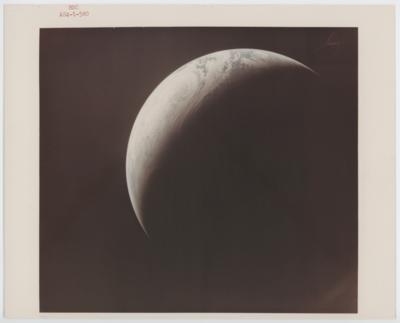NASA (Apollo 4)
The first color photograph of the whole Planet Earth, 9 November 1967
Vintage chromogenic print on fiber-based paper, printed 1967, numbered "MSC AS4-1-580"in red in top margin, with "A KODAK PAPER" watermark on verso, 20,3 x 25,4 cm
A milestone in the history of photography: it was the first time human beings could admire a color photograph of their whole planet floating in the dark void of space and this image provided a new perspective on our Home.
The photographic mission of Apollo 4 was the acquisition and return of the highest altitude color imagery ever made of the Earth, thanks to the first test launch of the Saturn V rocket, the giant space vehicle designed for the Moon landings.
Until then the highest altitude color photographs of the Earth had been recorded by the Gemini 11 crew using the rocket on their Agena target vehicle to raise their apogee to 741 nautical miles (1,373 km), the highest Earth orbit ever reached by a crewed spacecraft.
On November 9, 1967 the Apollo 4 (Spacecraft 017/Saturn 501) unmanned test flight made two orbits of the Earth before the third stage booster fired to send the capsule out in a vast ellipse peaking at 9,767 nautical miles, as a test of the translunar motors and of the high speed entry required of a manned flight returning from the moon.
“The [Saturn V] rocket will free man from his remaining chains,the chains of gravity which still tie him to this planet. It will open to him the gates of heaven.”
Wernher von Braun
A 70mm Maurer 220 G camera was programmed to look out a window, and took this fantastic photograph of the Earth from near "high apogee", as the Apollo 4 spacecraft, still attached to the S-IVB (third) stage, was orbiting Earth at an altitude of 9,544 miles.
The Earth (including Coastal Brazil, Atlantic Ocean, West Africa, Antarctica, looking west) is seen in a beautiful crescent. “This is a sight astronauts will see on the way to the Moon,” remarked at the time Samuel Phillips, Director of the Apollo Program, NASA (Cortright, p. 198).
Today, Apollo 4’s ghostly image of the Earth’s globe, pale and breathing, like a child in the womb awaiting its first human witness, has a peculiar fascination (Poole, pp. 86-87).
Literature:
The Last Whole Earth Catalog, June 1971, cover; Exploring Space with a Camera (NASA SP-168), Cortright, ed., pg. 199.
Expert: Mag. Eva Königseder
 Mag. Eva Königseder
Mag. Eva Königseder
+43-1-515 60-421
eva.koenigseder@dorotheum.at
27.09.2023 - 14:55
- Dosažená cena: **
-
EUR 2.860,-
- Odhadní cena:
-
EUR 2.500,- do EUR 4.000,-
- Vyvolávací cena:
-
EUR 1.300,-
NASA (Apollo 4)
The first color photograph of the whole Planet Earth, 9 November 1967
Vintage chromogenic print on fiber-based paper, printed 1967, numbered "MSC AS4-1-580"in red in top margin, with "A KODAK PAPER" watermark on verso, 20,3 x 25,4 cm
A milestone in the history of photography: it was the first time human beings could admire a color photograph of their whole planet floating in the dark void of space and this image provided a new perspective on our Home.
The photographic mission of Apollo 4 was the acquisition and return of the highest altitude color imagery ever made of the Earth, thanks to the first test launch of the Saturn V rocket, the giant space vehicle designed for the Moon landings.
Until then the highest altitude color photographs of the Earth had been recorded by the Gemini 11 crew using the rocket on their Agena target vehicle to raise their apogee to 741 nautical miles (1,373 km), the highest Earth orbit ever reached by a crewed spacecraft.
On November 9, 1967 the Apollo 4 (Spacecraft 017/Saturn 501) unmanned test flight made two orbits of the Earth before the third stage booster fired to send the capsule out in a vast ellipse peaking at 9,767 nautical miles, as a test of the translunar motors and of the high speed entry required of a manned flight returning from the moon.
“The [Saturn V] rocket will free man from his remaining chains,the chains of gravity which still tie him to this planet. It will open to him the gates of heaven.”
Wernher von Braun
A 70mm Maurer 220 G camera was programmed to look out a window, and took this fantastic photograph of the Earth from near "high apogee", as the Apollo 4 spacecraft, still attached to the S-IVB (third) stage, was orbiting Earth at an altitude of 9,544 miles.
The Earth (including Coastal Brazil, Atlantic Ocean, West Africa, Antarctica, looking west) is seen in a beautiful crescent. “This is a sight astronauts will see on the way to the Moon,” remarked at the time Samuel Phillips, Director of the Apollo Program, NASA (Cortright, p. 198).
Today, Apollo 4’s ghostly image of the Earth’s globe, pale and breathing, like a child in the womb awaiting its first human witness, has a peculiar fascination (Poole, pp. 86-87).
Literature:
The Last Whole Earth Catalog, June 1971, cover; Exploring Space with a Camera (NASA SP-168), Cortright, ed., pg. 199.
Expert: Mag. Eva Königseder
 Mag. Eva Königseder
Mag. Eva Königseder
+43-1-515 60-421
eva.koenigseder@dorotheum.at
|
Horká linka kupujících
Po-Pá: 10.00 - 17.00
kundendienst@dorotheum.at +43 1 515 60 200 |
| Aukce: | The Beauty of Space - Iconic Photographs of Early NASA Missions |
| Typ aukce: | Online aukce |
| Datum: | 27.09.2023 - 14:55 |
| Místo konání aukce: | Wien | Palais Dorotheum |
| Prohlídka: | Online |
** Kupní cena vč. poplatku kupujícího a DPH
Není již možné podávat příkazy ke koupi přes internet. Aukce se právě připravuje resp. byla již uskutečněna.
Všechny objekty umělce
Položky z jiných aukcí
- Werner Augustiner *
- Jagdliches Tranchierbesteck, Fa. Samuel Peace
- Madonna mit Kind, Süd-/Osteuropäisch, 19. Jahrhundert
- Matthias Bechtold (Deutschland, 1886-1940), Bronzeobjekt: Knabe mit Ball und spielender Katze, um 1920
- Bockflinte, Optima mit Weaverschiene, Wechselchoke, Kal.: 12/76 Stahlschrotbeschuß,

